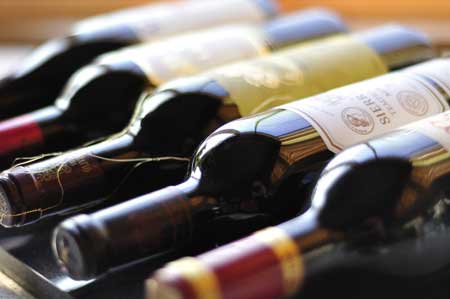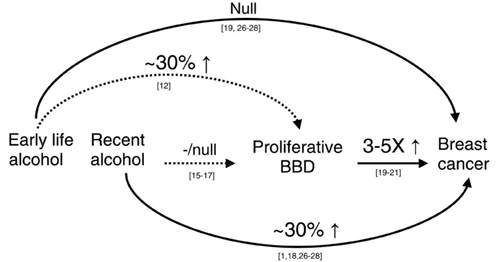Best Of Red Wine Cancer Connection
November 11, 2010 Written by JP [Font too small?]Red wine has a mixed reputation in the medical community. Some health authorities cite evidence that indicates it may be the one form of alcohol that provides actual health benefits. Generally speaking, the positive research regarding red wine has to do with its impact on cardiovascular health. In recent years, scientists have begun to analyze the specific chemical make up of this popular beverage. In doing so, they’ve discovered several phytochemicals that could be the reason why fermented grapes discourage heart disease. Furthermore, some of these substances have exhibited benefits in other arenas, such as anti-cancer activity in animal models and in-vitro (test tube) experiments. However, these laboratory findings are often at odds with population studies that find negative associations between alcohol consumption and cancer incidence. Today I’ll examine the most recent findings regarding the alcohol cancer connection.

The decision about whether to include red wine in your daily diet is an important one. There is considerable evidence that demonstrates its cardiovascular benefits. Since cardiovascular disease is the number one cause of premature mortality, we need to do all we can to prevent it. But breast and prostate cancers are significant health threats as well and it’s also vital to limit risk factors for those diseases. This is why the pros and cons of red wine need to be carefully evaluated. (1,2,3,4,5,6)
Several recent studies have specifically examined the role that red wine may have in the promotion of breast cancer. Here is a summary of those findings:
- The March 2009 Issue of Cancer Epidemiology, Biomarkers and Prevention – Over 6,300 women with breast cancer (BC) and 7,500 without were interviewed about their alcohol intake and other potential risk factors such as family history of the disease, age of first pregnancy and the use of hormone replacement therapy. The women who drank 2 or more alcoholic drinks a day were 24% more likely to have breast cancer. No differences were found in terms of what form of alcohol was consumed. The primary author of the study concluded that, “We found no difference between red or white wine in relation to breast cancer risk. Neither appears to have any benefits”. (7,8)
- The March 2009 Issue of the European Journal of Cancer – A study carried out by the oncology department at the Kaiser Permanente Medical Center examined the effects of beer, liquor and wine in over 2,800 women with BC. They discovered a dose-dependent increased risk of breast cancer for those who drank alcohol on a daily basis. This proposed threat did not seem to be influenced by the type of alcoholic beverage. (9)
These two recent studies are supported by previous research dating back over a decade. In 2001, over 61,000 women were followed for almost 10 years. About 1,300 of the participants developed breast cancer during that time frame. The older women who drank the most were 31% more likely to contract BC. A 1997 investigation in premenopausal French women likewise discovered an association between even small amounts of alcohol (60 calories per day) and breast cancer risk. Red wine was the predominant form of alcohol used by the trial subjects. (10,11)
This topic is controversial for several reasons: 1) Population studies are observational and not controlled. Often times, the conclusions found in such research doesn’t translate to real world results; 2) Other experiments indicate that red wine may actually combat the formation of dense breast tissue, which is also associated with increased BC risk; and 3) certain antioxidants in red wine (polyphenols and resveratrol) have exhibited protection against breast cancer growth and spread in animal and test tube studies. (12,13,14,15,16,17,18)

Breast and prostate cancers are linked by a few key features. Both diseases are influenced by sex hormones such as estrogen and testosterone and tend to manifest themselves in middle age or senior years. However, the connection between red wine and prostate cancer (PC) incidence is not as clear as in the case of breast cancer. Several epidemiological studies that have examined this proposed link:
- The April 2007 Issue of the International Journal of Cancer – A group of over 45,000 men were analyzed based on their “average consumption of red wine, white wine, beer and liquor”. Over the course of 16 years, about 3,300 were diagnosed with with prostate cancer. Drinking more than 4 glasses of red wine weekly seemed to slightly increase PC risk. But the change was so small and inconsistent that the authors concluded that, “red wine does not contribute appreciably to the etiology of prostate cancer”. (19)
- The March 2007 Issue of Harvard Men’s Health Watch – This report proclaimed that men who drank an average of 4-7 glasses of red wine per week were 52% less likely to develop PC. It also stated that an inverse association was found between red wine consumption and “advanced or aggressive cancers”. (20)
- Nutrition and Cancer 2006 – 34,565 men (aged 50-76) were monitored for two years via questionnaires. 816 of them were diagnosed with PC during that period. White wine consumption was associated with prostate cancer, but red wine was not. (21)
- The January 2005 Issue of the International Journal of Cancer – 753 middle aged men with PC were compared to 703 men who were disease free. Interviews about “lifetime alcohol consumption and other risk factors” were conducted with each participant. Overall, no link was found between total alcohol intake and PC. However, there was a 6% decrease in “relative risk” discovered for “each additional glass of red wine consumed per week”. The authors of the study commented that this may imply, “a reduced risk associated with increasing levels of red wine consumption”. (22)
A 1999 study in the journal Cancer Causes and Control determined that “fortified” and white wines appeared to increase PC risk, but red wine did not. It’s possible that resveratrol, an “antioxidant in red wine”, has an anti-PC effect. Resveratrol is being aggressively studied as a possible adjunct in the fight against PC and as a preventive aid. (23,24,25,26,27,28)
The question that begs to be answered is, “What is it about alcohol and/or wine that may spur the growth of cancer?”. A presentation given at a recent American Physiological Society annual meeting offers one possible explanation. A group of rats with breast cancer were fed diluted alcohol or pure water in order to replicate what may occur in a human model of BC. Over the course of 4 weeks, the researchers found that the rats that were fed the alcohol had tumors that were nearly twice the size of those in rats that were fed only water. It seems that the alcohol increased blood flow to the tumors (via microvessel growth), perhaps because of increased levels of a pro-cancer protein called VEGF (vascular endothelial growth factor). (29)
If it’s the actual alcohol in wine that is the problem, then using a dealchoholized red wine may be an option. New evidence presented in the Journal of Agricultural Food Chemistry has determined that removing alcohol from red wine does not adversely impact the level of beneficial substances. In fact, the dealcoholized red wines generally exhibited higher levels of phenolic antioxidants than the traditional red wines. In this analysis, Merlot reds were the top source of the highly esteemed resveratrol. (30)
There are many questions still left unanswered in this debate. However, based on the preponderance of the evidence, it might be wise to limit alcohol consumption (including red wine) if breast cancer is a significant concern. If you choose to include small to moderates amounts of alcohol in your diet, then perhaps a dealcoholized red wine could be a viable alternative. The connection between red wine and prostate cancer seems to have a rosier tint. I’ll be sure to look out for more details that will hopefully confirm a positive end to that story. In closing, I’d like to remind you that there are plenty of biodynamic and organic wines available at many health food stores and online. These products are free of pesticides and added sulfites (preservatives). This is the variety of red wine that we stock in our home.
Update: November 2010 – The correlation between cancer incidence and alcohol/wine consumption has been a frequent topic in the medical literature of late. Over the past several months, researchers spanning the globe from Zhejiang, China to Oakland, California have amassed summaries on the effects of various forms of alcohol and malignancy rates. Here are some of the key findings: a) wine appears to afford minor protective activity (-15%) in relation to bladder cancer occurrence; b) consuming 3 or more alcoholic drinks per week seems to increase the likelihood of breast cancer recurrence and cancer-related mortality in women diagnosed with “early-stage breast cancer”; c) wine was not associated with an elevated risk of endometrial cancer in a meta-analysis involving “20 case-control and seven cohort studies”; d) moderate red wine intake (2 glasses/day) didn’t impact colorectal cancer prevalence in a large “prospective, mutliethnic cohort (study) of middle-aged men”; e) having up to 3 alcoholic drinks daily is unlikely to influence prostate cancer risk, but heavier consumption of 7 or more drinks daily may contribute to “excess risk for this disease”. When it comes to alcohol/cancer connection, it’s becoming quite evident that avoidance or moderation is generally the best way to go. But it’s important to stay abreast of the latest research, as the knowledge base in this field is constantly evolving. Doing so may allow you to use alcohol in the safest possible way, if it enhances your lifestyle. (31,32,33,34,35)
Be well!
JP
Tags: Cancer, Resveratrol, Wine
Posted in Food and Drink, Men's Health, Women's Health

November 16th, 2010 at 11:29 am
Reservatrol, the substance found in the skin of grapes (and hence why Red wine has been correlated with this, and not white wine) has been shown to increase lifespan in a number of animals. It appears to have anti-aging properties.
That being said, all things in moderation. A glass a day. Even if it isn’t the wonder-drug it’s cracked up to be… who can argue with your doctor advocating a glass a day of merlot!
November 16th, 2010 at 1:16 pm
Dr. Lawson,
I agree re: cardiovascular disease. There’s little doubt that red wine is beneficial for many who are at risk for heart disease.
Be well!
JP
March 2nd, 2015 at 2:46 pm
Update: Organic, no-sulfite added red wines are higher in antioxidants …
http://www.sciencedirect.com/science/article/pii/S0308814615001806
Food Chem. 2015 Jul 15;179:336-42.
Polyphenols content, phenolics profile and antioxidant activity of organic red wines produced without sulfur dioxide/sulfites addition in comparison to conventional red wines.
Wine exerts beneficial effects on human health when it is drunk with moderation. Nevertheless, wine may also contain components negatively affecting human health. Among these, sulfites may induce adverse effects after ingestion. We examined total polyphenols and flavonoids content, phenolics profile and antioxidant activity of eight organic red wines produced without sulfur dioxide/sulfites addition in comparison to those of eight conventional red wines. Polyphenols and flavonoids content were slightly higher in organic wines in respect to conventional wines, however differences did not reach statistical significance. The phenolic acids profile was quite similar in both groups of wines. Antioxidant activity was higher in organic wines compared to conventional wines, although differences were not statistically significant. Our results indicate that organic red wines produced without sulfur dioxide/sulfites addition are comparable to conventional red wines with regard to the total polyphenols and flavonoids content, the phenolics profile and the antioxidant activity.
Be well!
JP